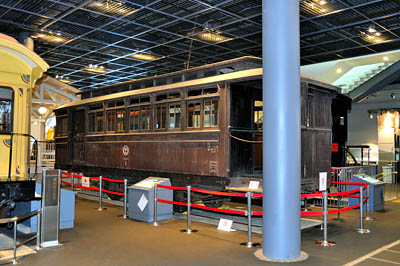
Electric Railcar
Class De963 |
The first urban Electrical Railcar |

|
|
Japan's first Electric Railway was a private company called the Kyoto-Denkikido Co.
(currently Kyoto Transportation Bureau) in Kyoto city during January 1895. In Tokyo, the first Electric Railway was also a private company called the Tokyo-Densha-Tetsudo Co. (currently Tokyo Metropolitan Government Bureau of Transportation) between Shimbashi and Shinagawa during August 1903. These were a streetcar type of railway. Japan's first full-rail-track type of electric urban railway was opened by the Kobu-Tetsudo Co. It's currently Tokyo's major commuter line (Chuo line). The Kobu-Tetsudo was first opened between Shinjuku and Tachikawa during April of 1889, and during April 1895, it was extended to Iidamachi. Kobu-Tetsudo was electrified between Iidamachi and Nakano on the 21st of August 1904, and started electric train services for the first time, except for a tram on the Japanese railroad.
The car's controller and other electrical components were imported from US General Electric, also there was a wheel truck from US J.G.Brill and Co, and the bodies were made at the Kobu-Tetsudo's Iidamachi shop. Those cars had two 600V 50 hp motors on board. The collecter consisted of two line, Trolley-Poles. And two cab models had two pair (four lines), one cab model had one pair of two line Trolley- Poles. On the 31st of December 1904, Kobu-Tetsudo line was extended to Ochanomizu station with electrification. With the expansion of the electrification, twelve Ha- No.17-28 were manufactured during 1906. However Kobu-Tetsudo was nationalized and these twenty-eight electric cars were transferred to the government railway on the first of October 1906. In this way, they became the first government railway's electric carriages.
After nationalization, the line was named Chuo line and extended line construction continued. On the 19th of April 1908, Shoheibashi was opened, and after the 1st of April 1912, Chuo line was completed to Manseibashi. Around this time, four more Ha- (No.29-32) were manufactured and the total number of cars became thirty-two. These 32 cars were divided into four classes by configuration, when class names were revised during 1910, that class consisted of NiDe-950, De-960, De-963 and De-989. However, these small cars could not catch up with the increasing number of passenger transportation volume. The Government Railway, consequently, produced a larger size 2 bogie commuter type electric car, and Series 963 were replaced by the heir cars during 1914-1915. A part of the retired Series 963 were transferred to the following four private railroad companys. Saku-Tetsudo (currently Koumi line on the JR-East) ; Total 6 Mikawa-Tetsudo (currently Mikawa line on the Nagoya Railway Co.) ; Total 10 Nansatsu-Tetsudo (after Makurazaki line on the Kagoshima-Kotsu Co.) ; Total 4 Shinano-Tetsudo (currently Oito line on the JR-East) ; Total 16 A few of these cars were transferred to other private railways, and most of these were later retired and scrapped from 1927 to 1955. |
|
Preserved car No.De-968 (1904 - 1955)
Among the 16 cars transferred to the Shinano-Tetsudo, De-968 was the ex-Kobu-Tesudo's Ha-9, and it was manufactured at the Iidamachi shop during 1904. It was named the Class De-963 No.968 during 1910. During July 1915, it was transferred to the Shinano-Tetsudo Co., with removed electrical components. It was named Shinano-Teysudo's Ha-6, and it was used as a steam train's trailer passenger car. Later it was remodeled and named the RoHaFu-1. During 1925, RoHaFu-1 and Ha-8 (ex-De-979) were transferred to the Chikuma-Tetsudo (currently Matsumoto Denki Tetsudo Co.) and they were named the Chikuma-Tetsudo's HaFu-1 and HaFu-2. During 1932, a part of the passenger room was remodeled to a luggage room, and again renamed the HaNiFu-1 and HaNiFu-2. After a short time, HaNiFu-2 was retired and scrapped. HaNiFu-1 was active up to 1949 but went into a reserve condition and it was retired during 1955. However, after it's retirement, HaNiFu-1 was accepted as worthwhile, as the original electric car, and the company kept that car at it's own Niimura shed. Afterward, the HaNiFu-1's preservation plan was considered several times by the JNR, but that never really happened. During March of 2007, HaNiFu-1's exhibition at the Railway Museum was decided, and it was donated from the Matsumoto Railway Co to JR-East. HaNiFu-1 is exhibited as a figure of the Matsumoto Railway years. It will be restored to the original De-963's apparent condition in the near future.
|
Introduction |
Go to Top |